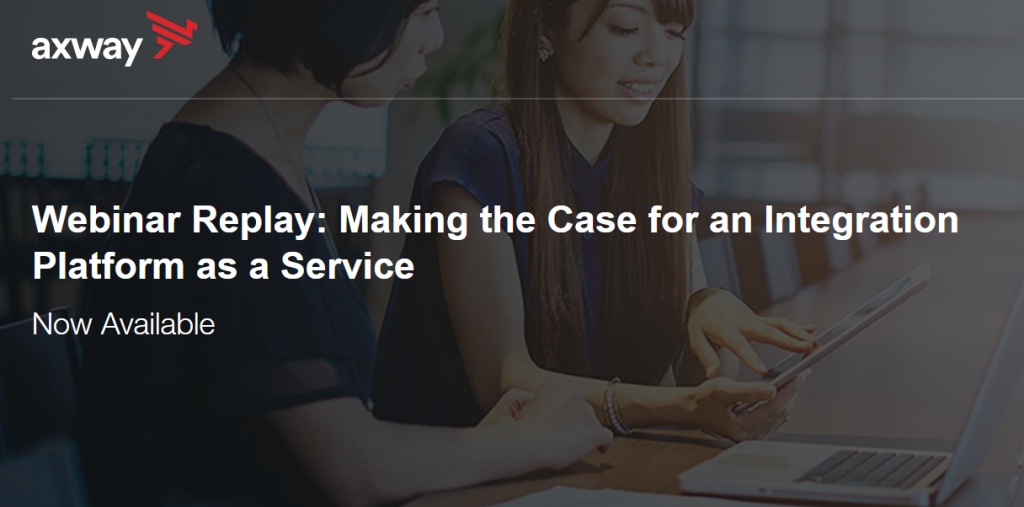An enterprise cannot run efficiently without a solid iPaaS solution for its integration demands. Handling your enterprise can involve the integration of a double-digit number of unique data sources from an increasingly complex mix of deployment types.
As Derek Brink, Vice President and Research Fellow at Aberdeen, revealed on the Axway/Aberdeen webinar “Making the Case for an Integration Platform as a Service,” iPaaS is becoming the go-to solution for a platform to solve the old legacy issues. It’s important to note that there is a “strong movement towards Integration Platform as a Service.”
These findings come from a new study conducted by the Aberdeen Group called “iPaaS is changing data integration management for successful companies.” In it, “95% of all respondents reported that the total volume of their enterprise data is growing year-over-year. Further, three out of four (74%) of respondents describe their current approach to integration as ad hoc or lacking any formal process whatsoever.”
With these numbers, it’s important to note that a “modern enterprise with a dynamic portfolio of applications, data sources, deployment types and integration mechanisms results in an overwhelmingly large number of potential integrations. Somewhere like 1,500 and 160,000, with a median of 26,000.”
Integration and iPaaS
Integration issues are one of the leading causes of delivering projects on time. This is a terrible precedent for any company. With iPaaS, companies can now deliver their projects on time in cloud-based delivery models—i.e., Integration Platform as a Service—this outnumbered interest in on-premises solutions by a factor of nearly 3 to 1.
For business users, integration abilities are the power behind the wheel to enable strategic initiatives. More and more companies are putting their investments into firm solutions to bring about “operating efficiencies, productivity, collaboration and digital transformation.”
For technical staff, integration can represent challenges that range from “speed and cost of integration to security, privacy and regulatory compliance.” Back in the day, IT’s main concern was “security, privacy, reliability and regulatory compliance.” The crucial need to improve governance over integration has furthered the iPaaS solution along as a mainframe platform.
Aberdeen pointed out that, “previous concerns are amplified by new drivers and new use cases.” This includes “applications, data sources, deployment models, users and endpoints.”
Today’s enterprises are redefining their IT initiatives for better complexity and workflows. It’s no surprise that concerns about security and compliance continue to exist, especially “when working with data that is valuable.” API usage is increased when data movements flow through many systems.
As the need for integration continues, capabilities are perpetually evolving. As Derek pointed out, “A platform approach to integration helps enterprises to realize more business value from its applications and data.” When asked about integration solutions that organizations plan to use in place of their current capabilities, interest in “cloud-based delivery models—i.e., Integration Platform as a Service. Improving speed and reducing cost is another main factor in selecting iPaaS for your enterprise.
READ MORE: Discover more information on iPaaS.
iPaaS solution
Bob Dylan certainly said it best, “The Times They Are A-Changin’.” This also applies to the economics of integration which is now changing. iPaaS is a key component of the hybrid integration platform AMPLIFY™ (HIP).
So, how does iPaaS work? It “simplifies the building, deployment and management of integrations between Ground to Ground, Cloud to Cloud, and Cloud to Ground.” As Shravanthi Reddy, Director Solutions and Product Marketing at Axway (webinar host) pointed out, “it seamlessly interconnects all systems and data sources rather than just sticking data together.” iPaaS is an important component of HIP.
READ MORE: Discover our solution brief.
Four key components for iPaaS
- AMPLIFY Integration Builder (connect and integrate).
- AMPLIFY Catalog (publish and share within one central location).
- AMPLIFY Central (manage and secure).
- AMPLIFY API Builder (open up and integrate for more efficiency with the use of APIs and microservices).
Furthermore, Axway’s iPaaS solution has over 170 pre-built connectors, an essential point to the solution. The iPaaS solution allows production time to build integrations and save over 66% in integration costs. With a faster time to market with new integrations, along with having connections to multiple category apps, iPaaS works to solve your integration needs.
Moreover, the iPaaS solution offers faster delivery and functionality, along with the process of integrating existing data and processes with new functions. Being able to simplify is a strong point for the solution.
The unified data model is an important aspect of the solution. It allows for consistency, reusability and predictability. iPaaS is more than just a solution, it offers the Integration Builder which allows for authentication, search and event framework. Also, Axway’s strength lies in its traditional API Management/Managed File Transfer/B2B/Content Collaboration patterns, microservices and mesh governances.
The Unified Catalog provides a central and unified catalog for the discovery and reuse of “integration artifacts that include APIs, microservices, application integrations and traditional flows.” Don’t miss out on our offer. Try the Application Integration for free: https://platform.axway.com.
Watch the webinar on how iPaaS can bring more value to your business and discover our infographic.
Discover our infographic.
